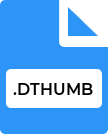.DTHUMB File Extension

Android Data Thumbnail
| Developer | |
| Popularity | |
| Category | System Files |
| Format | .DTHUMB |
| Cross Platform | Update Soon |
What is an DTHUMB file?
The .DTHUMB file extension, often encountered by Android users, represents a type of data thumbnail file primarily associated with the Android operating system.
These files are automatically generated by the Android system to create a smaller, compressed preview of an image or video file.
This allows for faster loading times in gallery applications and other media browsers by providing a lightweight version of the media that can be displayed without loading the full file.
The .DTHUMB files are crucial for enhancing user experience on Android devices, as they contribute to the efficient management of visual content.
More Information.
The development of the .DTHUMB file format can be traced back to the early versions of the Android operating system.
As Android evolved, the need for better media management tools became apparent, especially with the introduction of high-definition cameras on mobile devices.
Initially, the purpose of the .DTHUMB file was to ensure that users could quickly browse through their media files without experiencing delays or performance issues.
These files served as a bridge between the full-resolution media and the display system, enabling a smoother and faster user interface.
Origin Of This File.
The .DTHUMB file format originated as part of the Android operating system’s efforts to optimize the handling and display of media files on mobile devices.
As smartphones became more advanced, with cameras capable of capturing high-resolution images and videos, there was a need to manage these large files efficiently.
The Android OS introduced the .DTHUMB format to address this challenge, allowing the system to create and store thumbnail versions of media files, thereby reducing the load on the device’s resources when displaying image previews.
File Structure Technical Specification.
The .DTHUMB files are binary files that store a compressed version of the original image or video. The file structure typically includes metadata that helps the system quickly locate and display the thumbnail when needed.
This metadata might include the original file’s path, its dimensions, and the format in which it is stored. The actual thumbnail image is usually stored in a format that is optimized for quick loading, such as JPEG or PNG, although it is not directly accessible by the user.
The size of a .DTHUMB file is generally much smaller than the original media file, reflecting its role as a lightweight preview.
Technically, .DTHUMB files are designed to be read by the Android system and are not intended for direct user interaction.
They are automatically generated and managed by the system, with their creation and deletion typically handled as part of the operating system’s routine maintenance tasks.
This automated process ensures that the thumbnails are always up-to-date, corresponding to the current state of the media files on the device.
How to Convert the File?
Converting .DTHUMB files to a more standard image format like .JPEG or .PNG can be challenging, as they are not intended for direct use. There are methods available:
- Manual Conversion: If you need to convert a .DTHUMB file, one approach is to manually change the file extension to
.jpgor.png. However, this doesn’t always work since .DTHUMB files are not structured like standard image files. - Use Specialized Software: Some third-party software and tools can extract and convert the thumbnail data from .DTHUMB files. These tools are designed to handle the specific structure of .DTHUMB files and can convert them to standard image formats.
- Develop Custom Scripts: For those with programming knowledge, writing a custom script in a language like Python can help extract and convert the data from .DTHUMB files. This method provides more control but requires technical expertise.
Advantages And Disadvantages.
Advantages:
- Faster Loading Times: The primary advantage of .DTHUMB files is that they significantly reduce the time it takes to load image previews in gallery apps and other media browsers. This is particularly important on devices with limited processing power or large libraries of high-resolution images and videos.
- Optimized Resource Usage: By using thumbnails instead of full-size images, the Android system can save on processing power and memory usage, which helps to maintain the overall performance of the device.
- Enhanced User Experience: The use of .DTHUMB files contributes to a smoother and more responsive user interface, allowing users to browse their media collections without noticeable lag.
Disadvantages:
- Storage Space Consumption: Despite being smaller than the original media files, .DTHUMB files still occupy storage space. On devices with limited storage, the accumulation of these files can contribute to storage issues over time.
- Redundancy Issues: In some cases, .DTHUMB files may not be deleted automatically, leading to a buildup of unnecessary files that do not correspond to any existing media. This can result in wasted storage space.
- Limited User Control: Because .DTHUMB files are managed by the system, users have little control over their creation and deletion. This lack of control can be frustrating for those who are trying to optimize their device’s storage manually.
How to Open DTHUMB?
Open In Windows
- On a Windows PC, .DTHUMB files are not natively supported. If you transfer files from an Android device to a Windows computer, the .DTHUMB files may be included, but they will not be usable. Tools like file converters or thumbnail viewers might be able to open these files, but success is not guaranteed due to the specialized nature of the .DTHUMB format.
Open In Linux
- Linux systems, like Windows and macOS, do not have native support for .DTHUMB files. They will appear as unknown files and are not intended to be opened by users. However, technically proficient users might be able to access the contents using command-line tools or specialized software, although this is generally unnecessary.
Open In MAC
- Similar to Windows, macOS does not natively support .DTHUMB files. These files will typically appear as unknown file types if transferred from an Android device. Opening them would require specialized software or a file converter, although this is not generally recommended due to the potential for errors.
Open In Android
- On Android devices, .DTHUMB files are automatically handled by the system and are not meant to be opened directly by users. They are used internally by the operating system to display image previews in gallery apps and similar applications. Users generally do not need to interact with these files.











